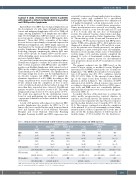Page 249 - 2021_06-Haematologica-web
P. 249
Letters to the Editor
A phase II study of brentuximab vedotin in patients with relapsed or refractory Epstein-Barr virus-positive and CD30-positive lymphomas
Epstein-Barr virus (EBV) has etiological implications in the development of a wide range of lymphoproliferative lesions and malignant lymphomas of B-cell or T/NK-cell origin. Among peripheral T-cell lymphomas and diffuse large B-cell lymphomas, EBV-associated cases have a poorer prognosis compared to that of EBV-negative lym- phomas.1,2 Given that CD30, a member of the tumor necrosis factor receptor family, is frequently expressed in EBV-infected lymphoid cells, CD30 might represent an ideal target for the treatment of EBV-positive and CD30- positive lymphomas. Brentuximab vedotin is an anti- body-drug conjugate comprising the chimeric IgG1 anti- body cAC10 specific for human CD30 and the micro- tubule-disrupting agent monomethyl auristatin E via a protease-cleavable linker.
An open-label, multicenter, investigator-initiated phase II study was designed to evaluate the activity of brentux- imab vedotin in patients with EBV-positive and CD30- positive non-Hodgkin lymphomas with various levels of CD30 in the relapsed or refractory setting (registered at Clinicaltrials.gov as NCT02388490). The optimal Simon two-stage design was used to test the null hypothesis of an objective response rate (ORR) of 20% against the alternative hypothesis of a 45% ORR. According to this design, ten patients were accrued in the first stage. Stage II was delayed until the completion of four or more cycles of study medication in the last subject in stage I. If more than three responders were observed, 15 additional patients would be accrued for a total of 25. This study design yields a type I error of 10% and a power of 90%. The study was approved by the institutional review board at each participating site and written informed consent was obtained in accordance with the Declaration of Helsinki.
A total of 25 patients with relapsed or refractory EBV- positive lymphomas also positive for CD30 (≥ 1% of tumor cells) were enrolled in this study between March 2016 and January 2018 at Seoul National University Hospital and Seoul National University Bundang Hospital. Positivity for EBV and CD30 expression was
reviewed by experienced hematopathologists in each par- ticipating center and confirmed by a specialized hematopathologist (YKJ). All patients were administered 1.8 mg/kg brentuximab vedotin intravenously every 3 weeks for up to 16 cycles or until disease progression. Tumor measurements were assessed at screening, after completion of cycle 2, every 6 weeks until cycle 16, and at 4 to 8 weeks after the last dose of brentuximab vedotin. The patients’ baseline characteristics and diag- nostic data are presented in Online Supplementary Table S1. The median age of the 20 men and 5 women was 67 years (range, 38-87) and most patients had EBV-positive mature T/NK-cell neoplasms (88%). Most patients were diagnosed at advanced stage (III or IV) and about a quar- ter of the patients were heavily pretreated; one patient had undergone a prior autologous stem cell transplant. Patients received a median of nine cycles of brentuximab vedotin (range, 1-16), and nine patients completed the planned 16 cycles of brentuximab vedotin administra- tion. The most common reasons for discontinuation were progressive disease (n=14, 56%) and adverse events (n=2, 8%).
The primary endpoint was the ORR based on the revised Cheson criteria or modified Severity Weighted Assessment Tool (SWAT) criteria in the case of cutaneous lymphomas.3,4 The ORR in the intention-to-treat popula- tion of 25 patients was 48% (90% confidence interval [CI]: 31%-64%) (Table 1). The amount of tumor shrink- age of the target lesion from baseline for individual patients is shown in Figure 1. The correlation of CD30 expression level with the clinical response was assessed according to subgroup analysis. However, CD30 expres- sion levels and ORR were not considerably different, although clinical responses were noted across all expres- sion levels (Table 1).
Secondary objectives of the study were to evaluate the safety profile, progression-free survival, duration of response, and overall survival. The duration of response was assessed in 12 patients who had objective responses and the median duration was 10 months (95% CI: 4.2- 21.0). The response continued even after the completion of the planned 16 cycles of brentuximab vedotin admin- istration in three of these 12 patients (25%) at the time of data cut-off. The median duration of follow-up was 20 months (range, 1.7-30.4 months). For the intention-to-
Table 1. Clinical outcomes of brentuximab vedotin treatment according to lymphoma subtype and CD30 expression.
Lymphoma subtype
CD30 expression
10-49% (n=5)
60%
60%
(n=3)
0%
(n=0)
8.7
(95% CI: 3.9-13.6) 9.7
(95% CI: 0-24.3) NE
≥ 50% (n=7)
43%
0%
(n = 0) 43%
(n = 3)
5.0
(95% CI: 0.6-9.3) 6.1
(95% CI: 0-14.6) 21.1
(95% CI: NE)
ORR
CR
PR
DoR (months)
PFS (months)
OS (months)
All (n=25)
48%
20%
(n=5)
28% (n=7)
10.1
(95% CI: 4.2-NE) 6.1
(95% CI: 2.8-13.5) 15.6
(95% CI: 6.1-NE)
Mature T/NK cell (n=22)
46%
18%
(n=4)
27% (n=6)
9.7
(95% CI: 7.1-12.4) 6.1
(95% CI: 0-13.9) 15.7
(95% CI: 4.2-27.1)
Mature B cell (n=3)
67%
33%
(n=1)
33% (n=1)
2.2
(95% CI: NE) 3.0
(95% CI: 0.5-5.5) NE
< 10% (n=13)
46%
15%
(n=2)
31% (n=4)
10.5
(95% CI: 3.7-17.2) 5.5
(95% CI: 0-15.3) 11.1
(95% CI: 0.8-21.5)
ORR: objective response rate; CR: complete remission; PR: partial remission; SD: stable disease; PD: progressive disease; DoR: duration of response; PFS: progression-free sur- vival; OS: overall survival; NE: not estimable; 95% CI: 95% confidence interval.
haematologica | 2021; 106(8)
2277


